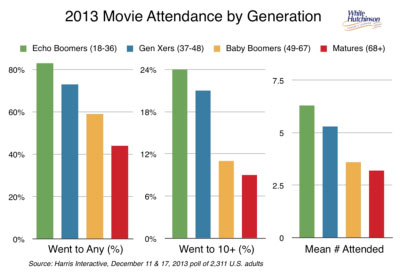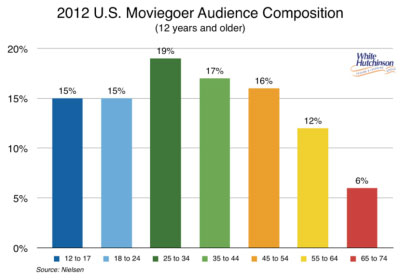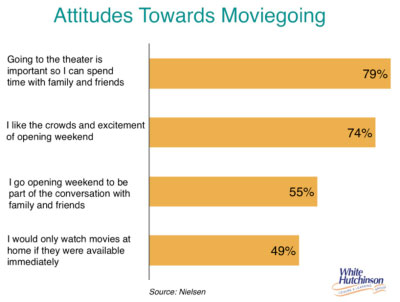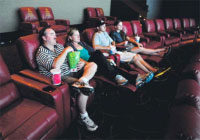
Vol. XIV, No. 1, January 2014
- Editor's corner
- Queue line design: theory versus perception
- Silverlake, the Family Place
- Four years after the economic recovery, America's birth rate remains depressed
- Foundations Entertainment University coming to Phoenix
- The Silver Screen is losing its shine
- Surfing in the desert
- Da Nang, Vietnam project gets a name
- It is very simply a people concept
- How to be friendly to food allergy sufferers
- The scoop on Chuck E. Cheese's going private
The Silver Screen is losing its shine
Our CEO was probably the first to publish a report and analysis of 2013 movie theater attendance results, or what the industry calls the box office, in his blog in January. As he reported in that blog posting, per capita movie attendance was down again in 2013, part of a long-term trend that began back in 2003.

A just released mid-December Harris Poll confirms the Silver Screen's slump. Their poll of 2,311 adults found that 68% of U.S. adults went to the movies at least once in 2013 and 17% said they went ten or more times. The mean number of movies attended was 4.8. However, two-thirds (66%) of those moviegoers said they were going to the movies less often than in a few years ago. Here's a graph that breaks down the attendance data Harris found by generations.

Harris asked survey respondents, “Do you prefer watching movies in a theater or at home?” 57% said they prefer at home, 21% preferred in a theater and 19% had no preference. For all generations, for both genders and for families with and without children in the household, the majority of all preferred watching movies at home.
When asked, “What are the best things about going to the movies? Please select 2 responses,” the top two answers were the sound and picture quality of a movie on the big screen (58%) and a short escape from everyday life (45%). Surprisingly, the third choice was advertisements that run before the previews (17%) - figure that?
And now for the worst things about going to the movies. Concession prices were the top choice at 62% and rude moviegoers (i.e., talking, texting, using phones, kicking seats) came in at 56%.
Concerning concession stand prices, 58% of moviegoers admitted to having snuck food into the movies. Millennials were the worse offenders (from the cinema's perspective) at two-thirds (67%) whereas only 36% of matures (68+) said they did. Perhaps that speaks to Millennials being less rule-bound than older generations.
Nielson recently publically released their 2012 American Moviegoing report that contained some interesting information. Here's their analysis of the composition of moviegoers by age.

They also asked their survey respondents about their attitudes about moviegoing.

What we find interesting about moviegoers' attitudes is that the number one reason that they go out to the movies is to be with and socialize with family and friends. That is consistent with every survey we have examined on why people go out to all different types of location-based entertainment venues, it's a way to socialize.
Movie chains are starting to fight back against the disruption of both high quality and easily accessible in-home movie viewing and mobile movie viewing. Back in the days of the black-and-white 19” television, movie going was highly competitive with the at-home viewing option. But now movie theaters are recognizing that much of what they offer other than the big screen and its sound is still rooted in that pre-digital era. Now with high-definition big-screen TVs, high-quality sound systems, Blu-ray and Internet streaming, they need to ramp up the experience of moviegoing to be competitive.

Take for example the movie theater seats. Other than cup holders, not that much has changed over the years. AMC Theaters has figured out that to compete with the living room sofa or the bed, they needed to change the seating. So what are they doing? They're ripping out the old style seats and replacing them with what they call plush power recliners. So far they have converted 25 theaters. And guess what, while destroying 2/3s (64%) of the auditoriums seating capacity and charging a higher price, attendance is up by 84%. That of course is also in auditoriums with 4K digital projection and the latest in sound systems.
What AMC also did for what they labeled anxiety removal is allow you to not only buy the ticket on-line in advance, but also pick your seat. What this does is reduce the time you spend between leaving home and the start of the movie, as now you don't have to arrive early to make sure after waiting in line to buy your ticket, you can get a good seat. Heck, with reserved seating you can even arrive a little later and miss all the advertisements that apparently, according to Harris many people enjoy, as well as missing the 15 to 20 minutes of trailers. That can easily save you one-half hour of valuable leisure time.
What this shows is what our company has been recommending and implementing with our clients for years, quality trumps going for quantity in the location-based entertainment industry. Today to win, it's all about offering a premium, upscale, High Fidelity experience if you want to get the consumer out of the house. And those consumers who do come are willing to pay a premium price for a quality experience that they find has great value for the amount of their limited leisure time they spend.
Movie theaters are also recognizing that to compete with consumers' other movie viewing options, they need to turn the theater into something you go to for more than just movies. They are changing the very nature of what a movie theater is by:
- Now with their conversion to digital projection, cinemas are showcasing digital broadcasts of everything from New York Ballet performances of the Nutcracker to the Metropolitan Opera's performance of Faust to Ultimate Fighting Championship matches to the previous soccer World Cup in 3-D
- Going way beyond the concession stand with popcorn and candy and becoming dining and drinking destinations by having in-house bars and lounges, cafes, restaurants and offering dinner and drinks while in the theater
- Becoming multi-entertainment venues with bowling, arcades and other entertainment attractions
We are in an era of rapid evolution and hybridization of location-based entertainment driven by rapid technological advances and changing consumer tastes, wants and expectations. Some in the movie industry have gotten the message and are evolving to continue to capture out-of-home leisure visits and spending. Other types of location-based entertainment face similar challenges and will need to also evolve to be relevant to consumers' leisure needs and preferences in the future.
Vol. XIV, No. 1, January 2014
- Editor's corner
- Queue line design: theory versus perception
- Silverlake, the Family Place
- Four years after the economic recovery, America's birth rate remains depressed
- Foundations Entertainment University coming to Phoenix
- The Silver Screen is losing its shine
- Surfing in the desert
- Da Nang, Vietnam project gets a name
- It is very simply a people concept
- How to be friendly to food allergy sufferers
- The scoop on Chuck E. Cheese's going private


